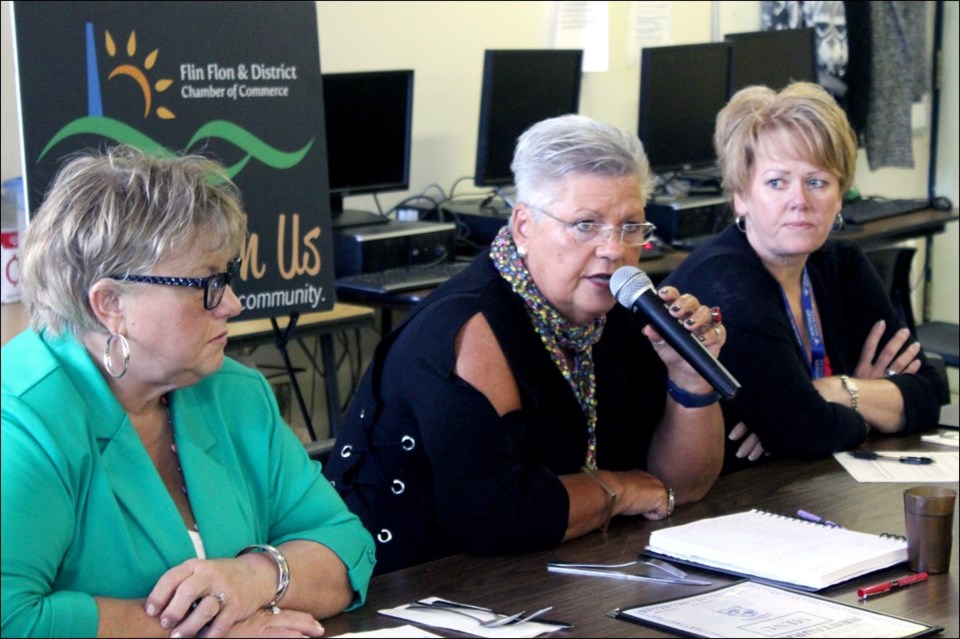The Northern Health Region (NHR) is still looking for a few physicians – and some financial help from the province.
Helga Bryant, CEO of the NHR gave an update at the March 27 meeting of the Flin Flon and District Chamber of Commerce. Bryant fielded questions from chamber members at the meeting and gave a detailed report of the NHR’s plans.
Physician staffing at Flin Flon General Hospital will not immediately change with the opening of the new ER project this summer. However, since staffing for physician positions is decided by the number of patients a hospital sees, Manitoba Health funds for more doctor positions may open up in Flin Flon once the expanded ER opens.
“That will change. Our visits [right now] are between 10 and 15 thousand,” said Bryant.
Currently, two doctors are employed by NHR in Flin Flon – short of the region’s provincially mandated quota of three funded doctor positions and two nurse practitioners. Recruitment efforts to fill the gaps are ongoing, said Bryant, but she confirmed that the openings have not yet been filled.
Bryant said the provincial quota is insufficient for Flin Flon and other communities, saying the NHR’s hands are tied on expansion due to a lack of new funding from the provincial government.
“For Flin Flon, we would need upward of, when you think of our catchment area, 10 or 11 primary care providers. We have no mechanism to even think of recruiting into those positions, because we have no budget for it and we have very clear directives around our financial monitoring,” she said, adding issues with position funding extend throughout the region.
“You can’t serve a community of [up to] 9,000 people with three providers. It’s impossible. There will be delays. There are delays in Thompson, there are delays in The Pas, because we are just chronically underfunded with physician positions.”
Bryant also referenced a comprehensive report, written by Nova Scotia-based medical consultant David Peachey for the Manitoba government in 2017. According to Bryant, the report showed funding from Manitoba Health for northern Manitoba as being between 17 and 20 primary care physicians short of regional needs.
“We’ve made huge strides in that, but our quota is three funded physician positions and two NP positions. That’s our reality,” said Bryant.
“We need to match our funding to our needs.”
While recruitment continues for physicians, Bryant said the NHR will continue to rely on locums – substitute physicians who come to Flin Flon on a part-time basis, usually from Winnipeg – to fill service gaps, describing the current locum system as “sound” and “sustainable.”
“That works very well. We have a group of committed physicians that live in Winnipeg that come to the north and provide a very good service when they’re here. I certainly hear from the public that they’re very pleased with the service that is provided,” said Bryant.
Cal Huntley, board chair for NHR and the mayor of Flin Flon, added, “We’ve been trying for years and years to get physicians to live in the community. It’s the vicious circle. We keep doing the same thing and expecting a different result. We have to try something different.”
Recruitment
Bryant said the NHR’s efforts to find doctors for Flin Flon and the north has been an uphill battle.
“It will be quite rare, I would expect from here on in, that we could get physicians to move to smaller communities. They want to live in Winnipeg, they want their kids to go to private school, they want all the things that they can have access to,” she said.
“That is just a reality that we need to wrap our heads around as a health care system.”
Bryant said the NHR’s recruitment efforts have been balanced toward both Canadian-born medical students and international students, eager to find work experience in Canada.
“This is their ticket into Canada and we’re finding, as time passes, that the quality of the international medical graduates is significantly improved in terms of the knowledge of our system,” said Bryant.
However, Bryant acknowledged that international medical graduates often leave the community not long after passing Canadian certification, calling it a “revolving door.”
“We know that’s the pattern. We want them to stay, but we know that they will leave,” she said.
Most discussions around recruitment have included locum-like terms, where doctors work in Flin Flon or other northern communities while living permanently elsewhere.
Bryant said the region had been in discussions with a group of medical graduates at the University of Manitoba, between 10 and 14 in all. The group would likely split their time between Winnipeg and the north.
“They’re pretty clear that they don’t want to live in the north. They want to work part time, they’d like to come up for a week or two and go back to Winnipeg for a week or two. They would like their travel and accommodations paid for, please and thank you, while they’re here. That’s what they’re telling us,” she said.
“We’re hopeful for this group of 10 to 14,” added Bryant.
The emphasis on more part-time physicians instead of permanently based doctors has left NHR administrators optimistic for potential recruits.
“We’re hopeful that this will provide some sustainable, different results than what we’ve experienced through the international rotation and things like that,” said Huntley.
Telehealth
Changes are coming to provincial telehealth, and Bryant thinks the change could be good for the north.
Bryant said a new telehealth application for desktop computers is being tested in Winnipeg, enabling more doctors to connect with northern patients.
While the system is still being rolled out, Bryant wants the north to be at the forefront for distance health consultation.
“We want to be first to get that because we could have such benefit from that. It is much more the Winnipeg end that is the challenge there,” she said.
While the system has earned rave reviews by some northern residents, things aren’t the same in Winnipeg. For Winnipeg-based physicians, where current telehealth systems are only available in some facilities at certain times, telehealth can be seen as an afterthought.
“Until we get a desktop computer system for telehealth, a physician at a clinic in southern Winnipeg is not going to go to a hospital where there is a telehealth unit. It’s a waste of time, they lose productivity, it interferes with the rhythm of the day,” said Bryant.
The new desktop system would allow distance patients to be able to see a doctor with almost no disturbance to their normal schedule.
“It would be in their office, in the examination room. They could see you on telehealth and then see me as a patient living down the road from them in Winnipeg. It’s that seamless,” said Bryant.
ER update
Meanwhile, the new emergency room at Flin Flon General Hospital is nearing completion.
“We can all see it. It’s looking like a beautiful building and it’s really looking finished inside,” said Bryant.
Bryant added the building will be ready for occupancy later this spring, with commissioning and final work still needing completion.
Just over $600,000 of the project’s community contribution still needs to be raised. Bryant said the health region is still reaching out to various organizations to help hit that mark.
“We’re looking to have the grand opening end of June, early July, around that time,” she said.
Bryant also announced there would be an increase in staffing once the ER opens up, specifying new positions in nursing, admitting and security, adding a request had been made to Manitoba Health by the region for additional operating dollars.
“With increased staffing and the standards that we certainly were not able to meet in our old space, we will be increasing staff numbers in the ER,” said Bryant.




